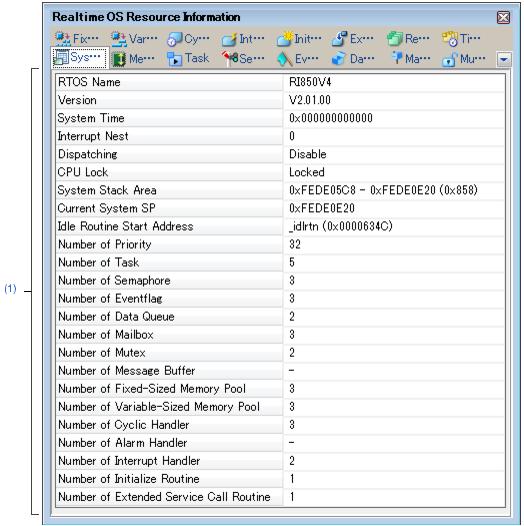|
|
The RTOS name "RI850V4" is shown.
|
|
|
The version of the RI850V4 is shown.
|
|
|
The system time of the RI850V4 (in milliseconds) is shown.
|
|
|
The nesting level of interrupt processes (including CPU exception processes) is shown.
|
|
|
The system state of the RI850V4 is shown.
|
|
|
|
|
|
|
|
|
The system state of the RI850V4 is shown.
|
|
|
|
|
|
|
|
|
The start address, end address, and size (in bytes) of the system stack are shown in the following format.
Start address - End address (Size)
|
|
|
If the processing program is operating on the system stack, the start address of the system stack is shown. If it is running on the task stack, then the current SP value is shown.
|
Idle Routine Start Address
|
The start address of the idle routine is shown.
|
|
|
The maximum priority of the task is shown.
|
|
|
The total number of tasks is shown.
|
|
|
The total number of semaphores is shown.
|
|
|
The total number of eventflags is shown.
|
|
|
The total number of data queues is shown.
|
|
|
The total number of mailboxes is shown.
|
|
|
The total number of mutexes is shown.
|
|
|
|
Number of Fixed-Sized Memory Pool
|
The total number of fixed-sized memory pools is shown.
|
Number of Variable-Sized Memory Pool
|
The total number of variable-sized memory pools is shown.
|
|
|
The total number of cyclic handlers is shown.
|
|
|
|
Number of Interrupt Handler
|
The total number of interrupt handlers/CPU exception handlers is shown.
|
Number of Initialize Routine
|
The total number of initialize routines is shown.
|
Number of Extended Service Call Routine
|
The total number of extended service call routines is shown.
|
